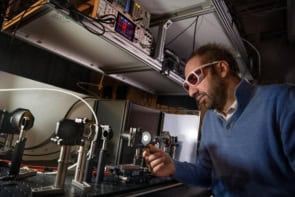
Three years ago, an international team of researchers observed something unexpected in a sample of chromium triiodide (CrI3): quasiparticles known as magnons appeared to be travelling along its edges, rather than moving through the sample’s bulk. This observation suggested that this two-dimensional layered magnetic material acts as a so-called topological magnon insulator – an unusual property with important applications in the field of dissipationless spintronics. But though the result sparked a flurry of interest in CrI3, the question of why the material behaves in this way remained unresolved.
Thanks to detailed neutron scattering measurements and extensive analyses, the same team has now found that the curious properties of CrI3 stem from the way its layers are stacked. Although single-layer CrI3 and the bulk material are ferromagnetic, two stacked layers are antiferromagnetic, meaning that the material’s magnetic moments point in opposite directions – a superficially simple difference with far-reaching consequences.
2D materials and topological insulators
Two-dimensional (2D) materials like CrI3 are made up of atomically thin layers stacked on top of each other. These layers are held together by weak van der Waals forces and the electrons in them behave very differently from those in bulk materials. For example, electrons in graphene, one of the best-known 2D materials, can move at almost relativistic speeds and behave as if they are massless.
Some 2D materials are also topological insulators – that is, materials in which electrons flow freely along the edges of a 2D sheet but cannot flow along the surface. This effect is related to the spin of the electrons, making these materials promising for spintronic devices, which store and process information using the electrons’ spin states.
Magnons for spintronics
Certain 2D magnetic materials are also predicted to be magnetic and topological insulators. In these materials, which are very rare, quasiparticles known as magnons travel along the edges of a sheet, much like electrons in a conventional 2D topological insulator. Magnons are collective oscillations of the spin magnetic moments of a material and they are expected to be massless (Dirac) particles too, meaning that they can travel over long distances without dissipating. This property would make them interesting for spintronics applications as well.
In the earlier experiments, Lebing Chen, a condensed-matter physicist at Rice University in the US, together with colleagues in the UK and South Korea, found such Dirac magnons in CrI3. The team came to this conclusion by studying the material using inelastic neutron scattering at the Spallation Neutron Source at Oak Ridge National Laboratory. In this technique, neutrons, which have magnetic moments, create magnons when they scatter from a sheet of CrI3, which has a honeycomb lattice structure much like graphene. By measuring the energy lost by the neutrons during the scattering process, Chen and colleagues were able to calculate the properties of these magnons. They found that they exhibit properties consistent with them being topological and having a dissipation-less edge mode.
Spin-orbit coupling
In the new work, described in Physical Review X, the researchers performed further neutron-scattering measurements with much greater precision and resolution. These results showed that the magnons’ topological properties arise thanks to spin-orbit coupling – a relativistic interaction between an electron’s spin and its motion. This coupling induces asymmetric interactions between spin of electrons in the materials, explains Elton Santos of the University of Edinburgh’s Higgs Centre, Jae-Ho Chung of Korea University’s Department of Physics and Rice’s Pengcheng Dai, who led the new study. These interactions make the spin “feel” the magnetic field differently, affecting their topological excitations. “Surprisingly the spins have some chirality, like in a mirror where left and right can work differently,” Santos says. “We observed that without such chiral interactions, or, in more complicated terms, Dzyaloshinskii-Moriya exchange, we can’t describe the data.”

Magnon transistors could give spintronics a boost
Chung adds that the result has an accompanying magnetic phenomenon too: a stacking-dependent magnetic order in which a single layer of CrI3 is ferromagnetic but two stacked layers are antiferromagnetic. “The reason for this behaviour is that the interaction between stacked layers in CrI3 is a combination of ferromagnetic and antiferromagnetic exchanges – despite apparent ferromagnetic stacking.”
“Our new work also confirms the previously observed topological nature of the spin excitation based on the Dzyaloshinkii-Moriya exchange, and rules out the competing interpretation based on the Kitaev exchange,” Dai tells Physics World. “The latter is known to be an important spin-spin interaction in more complex materials, like spin liquids, but apparently not for CrI3. This came as a surprise to us.”



